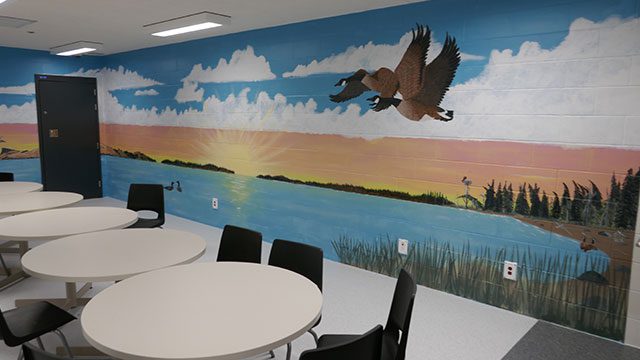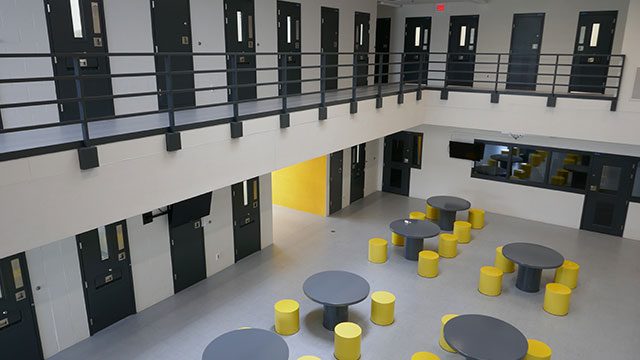A heavy metal door springs to life and slides open, letting Josiane Gendron walk into Sector B of the detention centre in Amos, Quebec.
“We are in the living quarters, sector B,” said Gendron, the assistant director of the new $125 million Amos facility that opened its doors in Nov. 2018.
Sector B is currently empty.
Natural light spills into the shared living space. Tables and chairs freshly painted different shades of grey with yellow highlights to impart some colour.
The cells are located on two floors, single rooms on the top, doubles on the bottom.
“The cells are open from 8:30 in the morning until 10:30 at night,” said Gendron. “So they have access to this room [lower level common area] during the day.”
Gendron said it’s a vast improvement over the old Amos prison that was notorious for overcrowding.
“Because there’s more room, in here, a bigger capacity, we were able to respect the agreement we have the KRG [Kativik Regional Government] and the Makivik corporation to group all the Inuit, the preventative custody Inuit, here in Amos.”
(Josiane Gendron, assistant director of the Amos detention centre. Photo: Tom Fennario/APTN)
On average, Inuit detainees make up more than a third of the 160 inmates here.
Unique to other prisons in Quebec, this facility also has a room designated for Inuit cultural activities.
Including a space to prepare traditional food that has a mural of a northern landscape on the wall.
“The painting was made by an incarcerated person from Cree and Inuit origin, so we hired him to do this painting to kind of give the feel of the north,” said Gendron.
(A mural on a prison wall depicting their traditional land is an apt metaphor for Inuit detained here. Photo: Tom Fennario/APTN)
In many ways they are stuck between two worlds.
Nunavik, the Inuit territory in subarctic Quebec, doesn’t have its own prison, so Inuit are ferried by plane back and forth – more than a thousand kilometres each way – from the time they’re arrested – to the end of their trial.
And depending on their case, or the weather, the time spent here can be extended by weeks or months.
As a result, Inuit spend significantly more time in custody than non-Inuit detainees, which makes it a human rights issue.
“Inuit rights are regularly infringed on, Inuit rights are not respected,” testified Lucy Grey at in November 2018 at a Quebec Inquiry into Indigenous Relations with Certain Public Services hearing In Kuujjuaq, QC.
Grey has held many titles within the justice system in Nunavik, from court translator to justice committee co-ordinator, to director of the Makitautik halfway house for Inuit offenders.
As a result, she had much to say about how justice is administered in Nunavik over the course of her impassioned hour long testimony.
“These Inuit are put in Amos, totally isolated, no one there to protect them, no one there to ease them, no one there to insure that they are corrected,” said Grey at the hearing “they always regularly come back more damaged, more hurt, and then they become repeat offenders.”
Grey isn’t the only one to lament the treatment of Inuit detainees.
A 2016 report by Quebec’s ombudsmen laid out dozens of recommendations to improve justice in Nunavik.
Most of which have been implemented, including improved services for Inuit at Amos, such as adult education.
“We have five classrooms,” said Gendron. “We will have a full time teacher in August, who will be hired by the Kativik school board.”
(Sector B at the Amos detention facility. Photo: Tom Fennario/APTN)
But as Grey points out, getting Inuktitut speakers to Amos is not easy.
Located in the Abitibi region of Quebec, Amos is almost 600 kilometres northwest of Montreal.
And about 1,200 kilometres from Nunavik’s closest courthouse where trials are held.
But Quebec has grouped Nunavik into the same judicial district as Abitibi despite the vast distance between the two regions.
“Abitibi might as well be across the ocean. Abitibi might as well be near Australia. We have no connection to Abitibi,” testified Grey, who adds there’s more Inuit resources in the Montreal region then Abitibi.
The Quebec ombudsmen report did make two specific recommendations to cut down on arduous travel.
Two and a half years later neither of which has been fully implemented.
One is the creation of direct flights from Nunavik villages to Amos, instead of going through Montreal or the Abitibi hub of Val d’Or and then bussing to Amos.
“It’s coming, it’s in development, we’ve no dates of when it’s going to come, but it’s definitely in the talks,” said Gendron.
(The new facility is 600 km northwest of Montreal, and 1,200 km from the nearest courthouse in Nunavik. Photo: Tom Fennario/APTN)
In an email to APTN News, Quebec’s Ministry of Public Security says it needed to wait for construction of the Amos prison to be finished and a new policing agreement for the Kativik police force, who help escort the prisoners, before acting on direct air lifts.
They also said that the first direct flight from Nunavik to Amos took place on July 4, but at the moment, it’s a pilot project and will only continue periodically.
As for the other solution to cut down on travel, using video conferencing for trial appearances, Gendron said the Amos prison is ready.
“Because of the internet link with the north, with Nunavik, it’s not been developed yet, it’s not taken place yet,” Gendron explained.
But the a spokesperson for the Kativik Regional Government, who administer services in Nunavik, say that internet speed is not the hold up, but rather negotiations with Quebec, which are ongoing.
Judging from the sound of frustration in her voice, for Lucy Grey these improvements cannot come soon enough.
“You know, Inuit are very forgiving, and the white, Qallunaat, “oui-oui”s kind of have a hard time with that, they want to punish. Punish. But the intention of justice is to bring social harmony and this version is not bringing harmony.
“It’s bringing chaos.”











